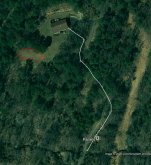dmharvey79
New Member
- Joined
- Jun 20, 2020
- Messages
- 7
Hello all. I purchased a home last fall and the previous owner (electrical engineer and general contractor) installed a smaller system a couple of years ago. I am totally new to the solar power scene, but generally handy with projects, and I'm thinking about building upon what the previous owner started. My goal is to establish enough power generation and storage to run our fridge, roughly 20 LED lights in our kitchen/living room area, and a couple of standard outlets 'indefinitely'...so maybe one or two existing circuits (with usage managed accordingly while relying on this solar power of course). I figure this is a good starting point and maybe I can expand the system to cover more of the house in the future...probably the well pump and a couple more existing circuits with LED lights and a couple of common household items plugged into outlets. Our home is on 10 wooded acres surrounded by over 3000 wood acres, about 50 miles west of DC, and I'm looking for this system to be something we can use in the event that we have a very long-term outage. For short-term weather outages we'll be using a dual-fuel emergency generator to power around 50% of the house.
Here is what I know about the existing system, based on my limited knowledge and a recent chat with the previous owner...five 100 watt panels tied to a power inverter in a clearing towards the end of our driveway, located about 500' from our house and main panel. Below is what the previous owner said when I emailed him for some additional details, and I'll include notes in parentheses for context.
"The solar panels I put in were more of an experiment to see what I could get per $$. But you are correct, they have grid tie inverters that backfeed into the lighting circuit that runs along the driveway. The circuit is tied through and each light is switched/photocelled (several light poles with outlets installed along the 200 yard long driveway) so there's not a break anywhere and continuous neutral. You will see the tie through when you pop open the LBs at each pole. It's 12 gauge wire from about halfway down the driveway to limit loss and I designed it to handle a full 1,500 watt load at 2% loss. That circuit actually runs from the panel, up through the master bath at the outlet next to the toilet then out. That was an extra circuit I had during the remodel so I just used it vs having to rewire."
I plan to poke around the forum as I get up to speed on solar power and various options for our system, but initial thoughts and suggestions are more than welcome. Thanks and I really look forward to working on this project as my schedule allows. Here are a few pictures...



Here is what I know about the existing system, based on my limited knowledge and a recent chat with the previous owner...five 100 watt panels tied to a power inverter in a clearing towards the end of our driveway, located about 500' from our house and main panel. Below is what the previous owner said when I emailed him for some additional details, and I'll include notes in parentheses for context.
"The solar panels I put in were more of an experiment to see what I could get per $$. But you are correct, they have grid tie inverters that backfeed into the lighting circuit that runs along the driveway. The circuit is tied through and each light is switched/photocelled (several light poles with outlets installed along the 200 yard long driveway) so there's not a break anywhere and continuous neutral. You will see the tie through when you pop open the LBs at each pole. It's 12 gauge wire from about halfway down the driveway to limit loss and I designed it to handle a full 1,500 watt load at 2% loss. That circuit actually runs from the panel, up through the master bath at the outlet next to the toilet then out. That was an extra circuit I had during the remodel so I just used it vs having to rewire."
I plan to poke around the forum as I get up to speed on solar power and various options for our system, but initial thoughts and suggestions are more than welcome. Thanks and I really look forward to working on this project as my schedule allows. Here are a few pictures...







